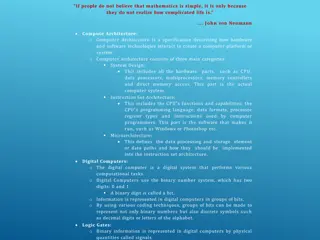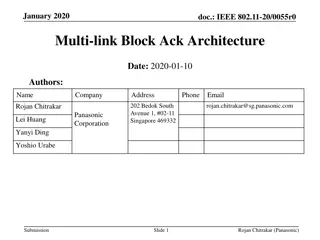Common Software Architecture Anti-Patterns
Anti-patterns in software architecture are commonly occurring solutions to problems that lead to negative consequences. These arise due to insufficient knowledge or experience, misuse of design patterns, and lack of attention to evolving project architecture. Examples include Jumble, Stovepipe, Spaghetti Code, Swiss Army Knife, Vendor Lock-In, Wolf Ticket, Cover Your Assets, Architecture by Implication, Design by Committee, Reinvent the Wheel, and The Grand Old Duke of York.
Download Presentation

Please find below an Image/Link to download the presentation.
The content on the website is provided AS IS for your information and personal use only. It may not be sold, licensed, or shared on other websites without obtaining consent from the author. Download presentation by click this link. If you encounter any issues during the download, it is possible that the publisher has removed the file from their server.
E N D
Presentation Transcript
Software Architecture Anti-Patterns
What are Anti-patterns? An Anti-Pattern describes a commonly occurring solution to a problem that generates decidedly negative consequences. Happens because an architect Does not have sufficient knowledge or experience solving a particular problem Applied a perfectly good design pattern in the wrong context Drift.. The project evolves and changes over time and no one is paying attention to the architecture.
Examples - 1 Jumble Horizontal and vertical design elements are intermixed (ball of mud). The result is unstable, and limits reusability. The layer pattern is violated. Stovepipe External systems and/or internal subsystems are integrated in an ad hoc point to point manner using multiple integration strategies and mechanisms. It is characterized by a lack of coordination and planning, extensibility and support are difficult. Spaghetti Code - Uncontrolled evolutionary development - Never taking time to refactor - As long as it works Swiss Army Knife An excessively complex component interface. The designer attempts to provide for all possible uses of the component.
Examples - 2 Vendor Lock-In - systems are highly dependent upon proprietary architectures. Architectural isolation layers can provide independence from vendor-specific solutions. Wolf Ticket A product claims openness and conformance to unenforceable standards. Interfaces may vary significantly from the published standard. Marketing motivated (term comes from rock concert ticket scalping)
Examples -3 Cover Your Assets Less-than-useful requirements are produced because important decisions are avoided and alternatives are elaborated. Obfuscates architecture design Architecture by Implication Lack of architecture planning and documentation due to architect over confidence or incompetence leads to implementation risks
Examples - 4 Design by Committee Design by Committee creates overly complex architectures that lack coherence. Clarification of architectural roles and improved process facilitation can refactor bad meeting processes into highly productive events. Reinvent the Wheel Pervasive lack of technology transfer between software projects leads to substantial reinvention. Design knowledge buried in legacy assets can be leveraged to reduce time-to-market, cost, and risk. The Grand Old Duke of York Egalitarian software processes often ignore people s talents to the detriment of the project. Programming skill does not equate to skill in defining abstractions. Distinguish between programmers and design modelers
References AntiPatterns, Muller, University of Victoria, http://www.csc.uvic.ca/~hausi/480/lectures/antipatterns.pdf https://sourcemaking.com/antipatterns/software-architecture- antipatterns

















































